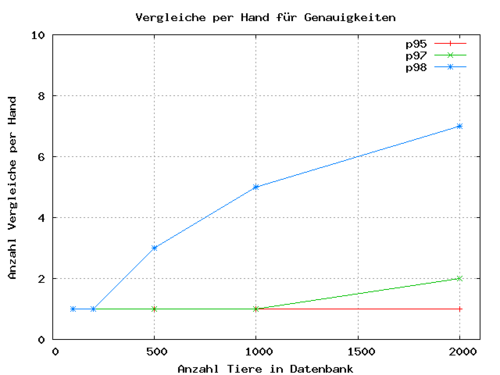Statistics
Recognition rate
AmphIdent reaches a very high recognition rate of about 98%. The following diagrams and tables show further information.
Crested newts
The following diagram visualizes the relation between size of the database and the recognition rate.
With a database size of 2000 individuals you need to compare 7 animals manually to reach a recognition rate of 98%. 95% of all assignments can be found with the comparison of only one pattern with a database size of 2000 individuals.
Extrapolating the course of the lines reveals that 98% of all assignments can be found by manual comparison of 10 patterns at a database size of 3000 individuals. 97% of all assignments will be even found with much larger databases.
Further investigations on the recognition rate for crested newts can be found in:
AXEL DRECHSLER, TOBIAS HELLING & SEBASTIAN STEINFARTZ: Genetic fingerprinting proves cross-correlated automatic photo-identification of individuals as highly efficient in large capture-mark-recapture studies in "Ecology and Evolution (2015)", Volume 5, Issue 1, pp. 141-151 Link
Duration of processing one picture
The processing of one photo divides into two steps:
- Create a pattern from the picture
- Comparison of this pattern with already existing ones.
The following table explains the time needed for processing pictures of different species:
| Species | Duration for pattern creation | Duration for comparison of the pattern | Overall time* |
|---|---|---|---|
| Crested newt | ~2min | 1ms | ~5min |
| Fire-bellied toad | ~1min | 1ms | ~5min |
* The time needed for comparison of one pattern with another. The value bases on a Pentium 4/3GHz.
**The shown Overall time approximates the duration of processing and comparison at a database size of 2500 patterns. For the final manual comparison two seconds per pattern were assumed.
The use of a faster PC will shorten the duration remarkably. With large databases the comparison is the most time-consuming task. Running a multi-core system will accelerate the process even further.
